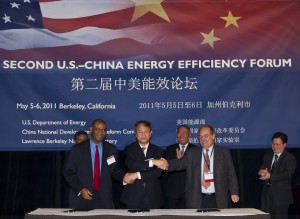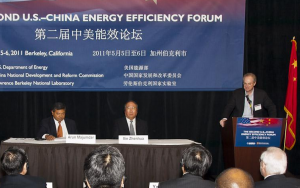As part of President Barack Obama’s commitment to strengthen cooperation with China in the area of clean energy, Lawrence Berkeley National Laboratory (Berkeley Lab) has entered into an agreement to provide training and other expertise to China’s National Energy Conservation Center (NECC).
Berkeley Lab and Oak Ridge National Laboratory, both U.S. Department of Energy (DOE) labs, signed a Memorandum of Understanding (MOU) on May 6 with the NECC in Berkeley, site of the two-day Second U.S.-China Energy Efficiency Forum, organized by the DOE and hosted by Berkeley Lab.
“The problems of energy and environment are so deep and pose so many challenges to peoples of all countries, we know that in order to tackle these problems we need inspired leadership as well as people in leadership roles to understand very deeply the technical issues we face today,” said Berkeley Lab director Paul Alivisatos in welcoming about 100 Chinese government officials and members of industry to the forum. “Energy efficiency is going to be one of the most important components of our future energy strategy.”

Johney Green of Oak Ridge National Laboratory, Li Yangzhi of China's National Energy Conservation Center and Mark Levine of Berkeley Lab's China Energy Group (left to right) sign an agreement to collaborate on energy efficiency. (Photos: Majed AbolFazli)
Both the MOU and the forum arose out of the U.S.–China Framework for the Ten-Year Cooperation on Energy and Environment, a package of initiatives announced in 2009 by Obama and President Hu Jintao. One of the measures, the Energy Efficiency Action Plan, calls for the two countries to work together to improve the energy efficiency of buildings, appliances and industrial facilities. The first forum was held last year in Beijing. This year’s forum brought together about 200 participants from U.S. government, industry, academia, and advocacy groups for small-group discussions with Chinese counterparts in four sectors: buildings and appliances, financing, industry and codes and standards.
“Under the bilateral Energy Efficiency Action Plan led by President Obama, a significant amount of progress has been made,” said Arun Majumdar, director of DOE’s ARPA-E, the Advanced Research Projects Agency-Energy, in remarks to the forum. “We should use this forum to identify new areas to improve our collaboration.”
On May 5, the first day of the two-day forum, the delegations toured Berkeley Lab to better understand the research being done in areas such as advanced windows and lighting systems and next-generation materials for solar energy and other clean energy applications.
The China Energy Group at Berkeley Lab has worked closely with Chinese government and industrial leaders for more than 20 years, analyzing and promoting energy efficiency in China. The Group has participated in the development of appliance standards and labeling, a benchmarking and policy analysis research for industries to identify and implement energy-efficiency options, and the development of tools and policies to reduce energy use in buildings.

Berkeley Lab Director Paul Alivisatos (right) welcomes ARPA-E Director Arun Majumdar and National Development and Reform Commission Vice Chairman Xie Zhenhua to the Second U.S.-China Energy Efficiency Forum.
Under the MOU with NECC, the China Energy Group, along with scientists from Oak Ridge, will train China in conducting energy assessments. “DOE has an excellent program in the United States for energy assessment of small, medium and large manufacturing facilities—we’re trying basically to transfer that program to China,” said Berkeley Lab scientist Lynn Price. “China doesn’t have an established program, and they’re really interested given their commitments to reduce energy and carbon dioxide intensity.”
The NECC, a relatively new agency under China’s National Development and Reform Commission, was announced in 2006 but has been ramping up only in the last few years, according to Price. The first joint activity under the MOU will be a three-day workshop for Chinese industry in Xi’an in June to demonstrate DOE’s energy assessment tool, Process Heating and Survey Assessment Tool (PHAST).
“We want to train the trainers,” Price said. “China now does audits to understand energy use, but it’s often more like bean counting. This tool shows where energy is being used and what opportunities there are to improve energy efficiency and reduce emissions. It shows, for example, if you put in this piece of more efficient equipment, you’d have x percent savings.”
Friday’s MOU represents continued progress in implementing the Energy Efficiency Action Plan with China. Berkeley Lab and Oak Ridge signed another MOU last year at the First U.S.-China Energy Efficiency Forum with the University Alliance for Industrial Energy Efficiency, which has been expanding rapidly, growing from 16 member universities last year to 33 now.
The U.S. scientists have been collaborating with the Alliance, which is modeled on a successful U.S. program, on workshops and trainings in industrial energy assessments; this year they will bring two U.S. DOE tools to China. The tools and expertise are expected to contribute to the Alliance’s program to conduct energy assessments of 10,000 enterprises, Price said.
Lawrence Berkeley National Laboratory addresses the world’s most urgent scientific challenges by advancing sustainable energy, protecting human health, creating new materials, and revealing the origin and fate of the universe. Founded in 1931, Berkeley Lab’s scientific expertise has been recognized with 12 Nobel prizes. The University of California manages Berkeley Lab for the U.S. Department of Energy’s Office of Science. For more, visit www.lbl.gov.
Additional Information:
- Energy Efficiency Action Plan fact sheet (PDF)